Chapter 9 Organizing and Enabling Success
LEARNING OBJECTIVES 1. Advise on how the organization can be structured to deliver a selected strategy. |
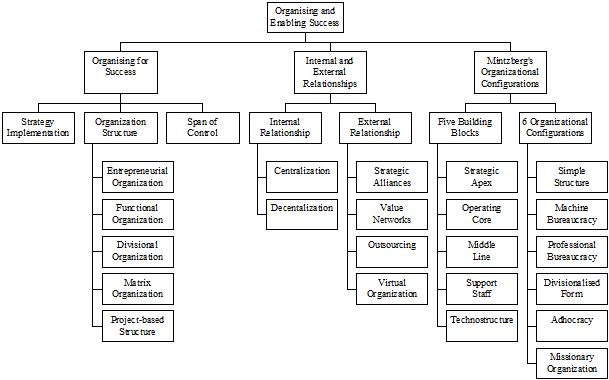
1. Organising for Success
1.1 Strategy implementation
1.1.1 After a strategic position analysis has been undertaken, available strategies have been evaluated and the preferred strategies have been selected, the selected strategies must be implemented. Achieving strategic objectives requires successful strategy implementation.
1.1.2 Strategy implementation takes the form of day-to-day actions and relationships. Three aspects of strategy implementation are specified in the syllabus for the Business Analysis paper:
(a) organisation structure, including the organisation of processes and relationships
(b) managing strategic change
(c) implementing strategy through a combination of intended strategy and emergent strategy.
1.2 Organization structure
1.2.1 Organisation structure is an aspect of strategy implementation. Strategy is implemented through actions, and actions are planned and controlled through the management and decision-making structure within the entity.
1.2.2 Organisation structures differ between entities. The organisation structure for an entity should be appropriate for the size of the entity, the nature of its operations, and what it is trying to achieve. Most important, the organisation must enable the entity to develop plans and implement them effectively.
1.2.3 There are several different types of organisation structure. Within a single entity, particularly a large entity, there might be a mixture of different organization structures, with different structures in different parts of the entity.
1.2.4 From a strategic perspective, however, the key question is: ‘What is the most appropriate structure for a particular entity that will help it to achieve its strategic objectives in the most efficient way?’
1.2.5 Organisation structures for multinational and global entities were described in an earlier chapter. You should also be familiar with the following basic structures that might exist within any entity or part of an entity:
(a) an entrepreneurial organisation structure
(b) a functional structure
(c) a divisional structure
(d) a matrix organisation.
1.3 Entrepreneurial organization
1.3.1 An entrepreneurial organisation is an entity that is managed by its entrepreneurial owner. The main features of an entrepreneurial organisation are usually that:
(a) the entrepreneur takes all the main decisions, and does not delegate decision making to anyone else
(b) the entity is therefore organised around the entrepreneur and there is no formal management structure
(c) operations and processes are likely to be simple, and the entity will probably sell just a small number of products or services.
1.3.2 An entrepreneurial structure is appropriate when an entity is in the early phase of its life. As it grows larger, however, an entrepreneurial structure will become inefficient, and a formal management structure is needed.
1.4 Functional organization structure
1.4.1 A functional structure is usually the next stage in the development of the organisation structure of a growing entity. In a functional organisation structure, decision-making authority is delegated in a formal arrangement, and responsibilities are divided between the managers of different activities or functions.
1.4.2 Typically, functions in a manufacturing entity include production (or operations), marketing and sales, and finance and accounting. There might also be a human relations function, an IT function, a research and development function, and so on.
1.4.3 An organization chart showing a simple functional structure is shown below.
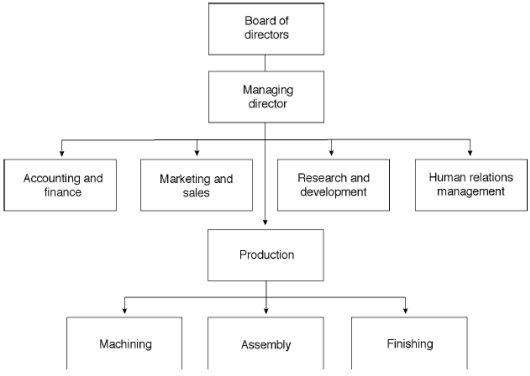
1.5 Divisional organization structure
1.5.1 As entities grow still further, and develop their business operations into different product-markets, a divisional structure might become appropriate. A division is an area of operations, defined by:
(a) markets in different geographical areas (for example, the European and the North American divisions).
(b) different products (for example the bus division and the rail division of a transport company).
(c) different customers (for example, industrial products and consumer products).
1.5.2 A division might be a strategic business unit of the entity (group). Each division has its own functional departments, such as marketing and sales, operations (production), accounting and finance, and so on.
1.5.3 Authority is delegated from head office to the divisional management (led perhaps by a divisional managing director), and responsibility for the implementation of product-market strategy is mainly at divisional level.
1.5.4 Head office retains overall control, and there may be some head office functions providing support services to all the divisions, such as corporate strategy, IT and research and development.
1.5.5 The simple organisation chart below shows the organisation structure for a divisionalised organisation with two divisions, where IT and research and development are head office support functions.
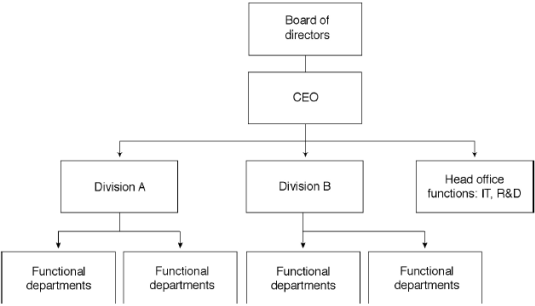
1.6 Matrix organization structure
1.6.1 Some entities have developed a matrix organisation structure for some of their activities. The matrix organisation originated in the 1950s and 1960s, in entities where it was recognised that different functions within the entity needed to work closely together. Horizontal relationships across different functions were as important as the ‘traditional’ reporting relationship within functions.
1.6.2 Matrix organisations and project organisation structures were both first used in the defence and aerospace industries, where companies were required to carry out major projects for customers, such as building a quantity of aircraft for a government customer.
1.6.3 The challenge was to complete projects on time and on budget. However, the traditional functional structure within the construction companies meant that no one was responsible for the project as a whole. A matrix organisation or project management organisation was introduced to overcome the problem.
(a) Project managers were appointed with overall responsibility for individual projects. Project managers had to organise the efforts of individuals in all the different functions.
(b) At the same time, functional managers such as management of engineering, production and sales and marketing, retained their decision-making authority.
1.6.4 In this way, a dual command structure was created. In a matrix organisation, the traditional vertical command structure has an overlay of horizontal authority or influence.
1.6.5 A matrix organisation has been defined as: ‘any organisation that employs a multiple command system that includes not only a multiple command structure but also related support mechanisms and an associated organisational culture and behaviour pattern’ (Davis and Lawrence 1977).
1.6.6 The difference between a matrix organisation structure and a project organisation is that with a project organisation, the project management comes to an end when the project ends. With matrix organisation, the matrix structure of authority and command is permanent.
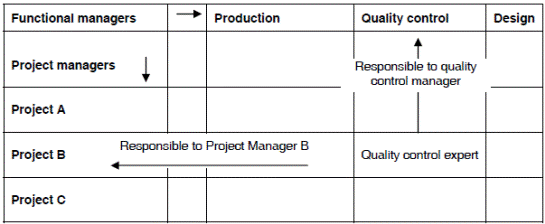
1.6.7 In the diagram above, the person shown is a quality control expert and is responsible to the quality control manager for technical aspects of the job, maintaining quality systems and so on.
1.6.8 The person is also responsible to the manager of Project B. That manager will be concerned with completing the project on time, within the cost budget and to the proper standard.
1.6.9 Obviously conflicts can arise: the project manager might want to skip some tests to make up time, but the quality control department won’t want to do that. Both can put the employee under some pressure. However the matrix structure should allow the employee to ask the two managers to discuss the problem, as it is plain that they are both involved.
1.6.10 Overall, matrix structures should:
(a) encourage communication
(b) place emphasis on ‘getting the job done’ rather than each manager defending his or her own position.
(c) be suitable for fairly large number of different functions.
1.6.11 |
Example 1 |
|
A multinational company produces three sets of product ranges (Product A, Product B and Product C) and sells the product in three geographical areas (Europe, USA and South America). The management of each product range is equally important, as is the responsiveness to the needs of the different geographical areas. The product managers and area managers have equal weight. Thus the manager of the USA area must liaise with the managers of Product A, B and C but does not have authority over them or vice versa.
|
1.6.12 Advantages of a matrix structure
(a) It offers greater flexibility. This applies both to people, as employees adapt more quickly to a new challenge or new task, and develop an attitude which is geared to accepting change; and to task and structure. Flexibility should facilitate efficient operations in the face of change.
(b) It should improve communication within the organization.
(c) Dual authority gives the organization multiple orientation so that functional specialists do not get wrapped up in their own concerns.
(d) It provides a structure for allocating responsibility to managers for end-results. A product manager is responsible for product profitability, and a project leader is responsible for ensuring that the task is completed.
(e) It provides for inter-disciplinary cooperation and a mixing of skills and expertise.
1.6.13 Disadvantages of matrix organization
(a) Dual authority threatens a conflict between managers. Where matrix structure exists, it is important that the authority of superiors should not overlap and areas of authority must be clearly defined. Subordinates must know to which superior they are responsible for each aspect of their duties.
(b) One individual with two or more bosses is more likely to suffer role stress at work.
(c) It is sometimes more costly – e.g. product managers are additional jobs which would not be required in a simple structure of functional departmentation.
(d) It may be difficult for the management to accept a matrix structure. It is possible that a manager may feel threatened that another manager will usurp (奪取,侵佔) his or her authority.
(e) It requires consensus and agreement which may slow down decision-making.
1.7 Project-based and team-based structures
1.7.1 In addition to having a formal management structure, entities might also used project teams and other management teams to implement some activities.
1.7.2 Project teams are usually assembled to accomplish a specific task, such as introducing a new system or a new process. The project team should consist of members from different disciplines or functions, so that a wide range of skills is assembled to implement the project.
1.7.3 This is very similar to matrix management, but is based on ad hoc cross-functional teams with responsibility for a defined project and have a finite life.
1.8 Span of control
1.8.1 The span of control refers to the number of people who directly report to a manager in a hierarchical management ‘command’ structure. There are two extreme shapes:
(a) Tall-narrow. In this type of structure, each manager has a small number of subordinates reporting directly to him. As a result, in a large organisation, there are many layers of management from the top down to supervisor level. The span of control is narrow, and the shape of the organisation structure is tall, because of the many layers of management.
(b) Wide-flat. In this type of structure each manager has a large number of subordinates reporting directly to him. As a result, even in a large organization, there are only a few layers of management from the top down to supervisor level. The span of control is wide, and the shape of the organisation structure is flat, because of the small number of management levels.
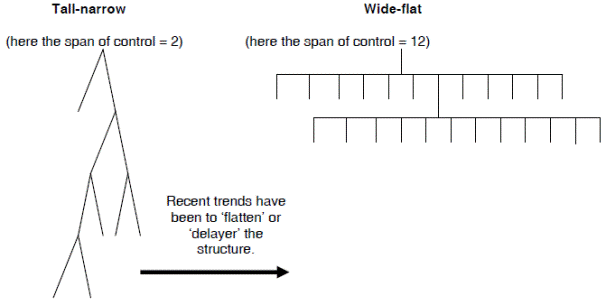
1.8.2 Wider and flatter organisation structures have replaced tall bureaucratic structures in many organisations. The reasons why wide-flat organisations are often preferred are as follows.
(a) Wide-flat structures are more suitable to rapidly-changing business environments, where entities must respond to changes quickly and with flexibility. An organisation in which information travels quickly and decisions can be made quickly is more appropriate in these circumstances that a structure that is more formal and hierarchical.
(b) Cost savings. It has been argued that in a tall-narrow organisation, managers spend too much time managing each other, instead of adding value. If middle managers do not add value, they should be eliminated from the organization structure.
Question 1 Hudson is convinced that a significant cause of the problem is the way that the company is organized. It has been shown that a competitive advantage can be obtained by the way a firm organizes and performs its activities. ALG Technology is currently structured on a functional basis, which does not seem to work well with complex technologies when operating in dynamic markets. The functional structure appears to result in a lack of integration of key activities, reduced loyalties and an absence of team work. Hudson has contemplated moving towards a divisionalised structure, either by product or by market so as to provide some element of focus, but his experience has suggested that such a structure might create internal rivalries and competition which could adversely affect the performance of the company. Furthermore there is a risk that such a structure may lead to an over-emphasis on either the technology or the market conditions. He is seeking a structure that will encourage both integration and efficiency. Any tendency towards decentralization, whilst encouraging initiative and generating motivation may result in a failure to pursue a cohesive strategy, whereas a move towards centralization could reduce flexibility and responsiveness. The company is already relatively lean and so any move towards delayering, resulting in a flatter organization is likely to be resisted. Furthermore the nature of the market – the need for high technical specifications and confidentiality – is likely to preclude outsourcing as a means of achieving both efficiency and rapidity of response. Required: |
2. Internal and External Relationships
2.1 Organisational relationships and implementing strategy
2.1.1 Plans are put into action by the co-ordinated efforts of many individuals and groups within the entity. The way in which plans are implemented depends on:
(a) the nature of internal relationships: these are relationships between different parts of the organisation
(b) the nature of external relationships: in many entities a significant amount of work is done by other entities and individuals who are external to the entity and not a part of it.
2.2 Internal relationships: centralization versus decentalisation
2.2.1 An important aspect of internal relationships is the extent to which decision-making is centralised, so that major planning decisions are made (and implemented) by ‘head office’, or decentralised.
(a) In a centralised organisation, senior management retain most (or all) of the authority to make the important decisions.
(b) In a decentralised organisation, the authority to take major decisions is delegated to the management of units at lower levels in the organisation structure, such as SBU managers, and divisional managers.
2.2.2 The choice between a centralised and a decentralised organisation depends to some extent on the preference of senior management. However, the size and complexity of the entity also influence the extent to which decision-making, planning and control are centralised or decentralise (‘devolved’). It is difficult to control a large and complex entity from head office, without delegating substantial amounts of authority to divisional managers.
2.2.3 Advantages of centralization are as follows:
(a) Decisions by management are more likely to be taken with regard for the corporate objectives of the entity as a whole. There is a very strong argument in favour of making strategic decisions centrally.
(b) Decisions by management should be co-ordinated more effectively if all the key decisions are taken centrally.
(c) In a crisis, it is easier to make important decisions centrally.
2.2.4 Advantages of centralization:
Advantage |
Comment |
Control |
Senior management can exercise greater control over the activities of the organization and coordinate their subordinates or sub-units more easily. |
Standardization |
Procedures can be standardized throughout the organization. |
Corporate view |
Senior managers can make decisions from the point of view of the organization as a whole, whereas subordinates would tend to make decisions from the point of view of their own department or section. |
Balance of power |
Centralized control enables an organization to maintain a balance between different functions or departments. |
Experience counts |
Senior managers ought to be more experienced and skilful in making decisions. |
Lower overheads |
When authority is delegated, there is often a duplication of management effort (and a corresponding increase in staff numbers) at lower levels of hierarchy. |
Leadership |
In times of crisis, the organization may need strong leadership by a central group of senior managers. |
2.2.5 Advantages of decentralization/devolution of authority:
Advantage |
Comment |
Workload |
It reduces the stress and burdens of senior management. |
Job |
It provides subordinates with greater job satisfaction by giving them more say in making decisions which affect their work. |
Local knowledge |
Subordinates may have a better knowledge than senior management of ‘local’ conditions affecting their area of work. |
Flexibility and speed |
Delegation should allow flexibility and a quicker response to changing conditions. If problems do not have to be referred up a scalar chain of command to senior managers for a decision, decision-making will be quicker. |
Training |
Management at middle and junior levels are groomed for eventual senior management positions. |
Control |
By establishing appropriate sub-units or profits centres to which authority is delegated, the system of control within the organization might be improved. |
2.3 External relationships
2.3.1 An entity might use external relationships to deliver a particular strategy. These are relationships with other entities, or with individuals who are not a part of the entity but are external to it. External relationships may take the form of:
(a) strategic alliances
(b) value networks
(c) outsourcing of functions
(d) virtual organisation
2.3.2 Strategic alliances (including joint ventures) and value networks have been described in earlier chapters.
(a) Outsourcing
2.3.3 An entity does not need to carry out operations itself. Instead, it can outsource work to a sub-contractor.
2.3.4 Outsourcing is common in certain industries, such as the construction industry. It is also common to outsource ‘non-core’ activities, such as the management of the entity’s fleet of motor vehicles, security services, some IT work and some accountancy work (for example, payroll operations).
2.3.5 The size of an entity, and its organisation structure, will depend to some extent on how much of its operational activities it chooses to outsource.
2.3.6 The reason for outsourcing:
Outsourcing is consistent with the view that an entity achieves competitive advantage by concentrating on its core competencies. It does not achieve competitive advantage doing work that can be done just as well – if not much better – by another entity.
(a) The entity should therefore focus activities within the entity on core competencies, with the aim of gaining more competitive advantage in these core areas.
(b) The entity should outsource work to entities that have core competencies in these areas of work. They should be able to add value more effectively than the entity would if it were to carry out the work internally instead of outsourcing it.
(c) The outsourced work might require specialist skills that the entity cannot employ internally, because it cannot offer enough work or a career structure to full-time specialists. It therefore outsources its specialist work to specialist firms.
2.3.7 Problems with outsourcing:
A potential problem with outsourcing is the loss of control over the outsourced activities. This can be significant when something goes wrong, and action performance does not meet expectations.
For example a company might outsource its IT work and might commission a software company to write some new software. The software, when written, might not function properly. The problem is then to manage the external relationship with the software company, to find a satisfactory solution to the problem.
(b) The virtual organization
2.3.8 The virtual company or virtual organisation does not have an identifiable physical existence, in the sense that it does not have a head office or operational premises. It might not have any employees.
2.3.9 A virtual organisation is operated by means of:
(a) IT systems and communications networks – normally telephone and e-mail
(b) business contacts for outsourcing all operations.
2.3.10 |
Example 2 |
|
Many small businesses operate as virtual organisations. For example, a house builder might operate his business from his home. When asked to build a new house, he can hire all the labour – skilled and unskilled – that he needs to do the work, supervise it and check it. He can employ a firm of accountants to deal with the invoicing and payments. The builder does not need an office, or full-time employees. His core competence is his personal skill and experience, which he should use to give his firm its competitive advantage over rival house builders. In the same way, there is no reason why a larger business should not be operated as a virtual company. For example, a company that sells branded footwear could operate as a virtual company, using its brand name as its major core competence. It could outsource all its value chain and support activities. Manufacture could be outsourced to producers in developing countries, warehousing companies could be used to hold inventories. A network of self-employed sales representatives might be used to sell the footwear into retail organisations, and marketing activities might be outsourced to an external agency. |
2.3.11 One person, or a small number of individuals, can operate a virtual organization and indirectly control the actions of many ‘external’ entities and individuals.
2.3.12 A key to a successful virtual organisation is the successful management of all the different external relationships, and successful co-ordination of their activities.
3. The Most Appropriate Organization Structure – Mintzberg’s Organizational Configurations
3.1 Mintzberg’s five building blocks for organizational configurations
3.1.1 Mintzberg argues that an organisation structure exists to co-ordinate the activities of different individuals and work processes, and to implement plans into action. The nature of the organisation structure varies with differences in processes and internal and external relationships. He suggested that there are five elements or ‘building blocks’ in an organisation. The way in which an entity is organised most effectively depends on which of these elements is dominant.
3.1.2 These five elements are shown in the diagram below.
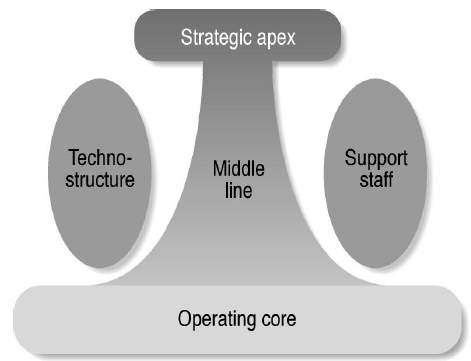
3.1.3 The five components:
Components |
Explanations |
Strategic apex (頂點) |
|
Operating core |
|
Middle line |
|
Support staff |
|
Technostructure |
|
3.2 Mintzberg’s six organizational configurations
3.2.1 Mintzberg identified six different organisational configurations, each having a different mix of the five building blocks. He suggested that the most suitable organisational configuration would depend on the type and complexity of the work done by the entity. The six configurations are:
(a) simple structure
(b) machine bureaucracy
(c) professional bureaucracy
(d) divisionalised form
(e) adhocracy
(f) missionary organisation
(a) Simple structure
3.2.2 This is found in an entrepreneurial company. The strategic apex exercises direct control over the operating core, and there is no middle line. There is also little or no support staff or technostructure. The strategic apex might be an owner-director of the company. This type of structure is very flexible, and can react quickly to changes in the environment, because the strategic apex controls the operating core directly.
(b) Machine bureaucracy
3.2.3 In a machine bureaucracy, the technostructure is the dominant element in the organisation. The entity is controlled and regulated by a bureaucracy and the emphasis is on control through regulation. It is difficult for an entity with this type of organisation to react quickly to environmental change. This structure is therefore more suitable for entities that operate in a stable business environment.
(c) Professional bureaucracy
3.2.4 In this type of structure, the operating core is the dominant element. Mintzberg gave the name ‘professional bureaucracy’ to this type of structure because it is often found in entities where the operating core consists of highly-skilled professional individuals (such as investment bankers in a bank, programmers in a software firm, doctors in a hospital, accountants and lawyers in a professional practice, and so on).
(d) Divisionalised form
3.2.5 In this type of structure, the middle line is the dominant element. There is a large group of powerful executive managers, and the organisation structure is a divisionalised structure, each led by a divisional manager. In some divisionalised structures, divisional managers are very powerful, and are able to restrict the influence of the strategic apex on decision-making.
(e) Adhocracy
3.2.6 Mintzberg identified a type of organisation that he called an ‘adhocracy’. This is an organisation with a complex and disordered structure, making extensive use of teamwork and project-based work. This type of organisation will be found in a complex and dynamic business environment, where innovation is essential for success. These organisations might establish working relationships with external consultancies and experts. The ‘support staff’ element can therefore be very important.
(f) Missionary organizations
3.2.7 In this type of organisation, all the members share a common set of beliefs and values. There is usually an unwillingness to compromise or accept change. This type of organisation is only appropriate for small entities that operate in simple and fairly static business environments.
(g) Differences between the six organizational configurations
3.2.8 The differences between the six organisational configurations are summarized below. Note in particular how each configuration is likely to be suitable for different types of business environment and different types of organisational relationships. The main controlling and co-ordinating factor within each type of configuration also differs.
|
Business environment |
Internal features |
Key organizational element |
Main coordinating factor |
Simple structure |
Simple and dynamic |
Small entity, |
Strategic apex |
Direct control by strategic apex |
Machine bureaucracy |
Simple and static |
Large and well established. |
Technostructure |
Standardized procedures |
Professional bureaucracy |
Complex but static |
Simple processes. Control by professionals |
Operating core |
Standardization of skills |
Divisionalised form |
Fairly static. |
Large and well established. |
Middle line |
Standardization of outputs |
Adhocracy |
Complex and dynamic |
Complex tasks. |
Support staff or operating core |
Flexibility and adaption |
Missionary organization |
Simple and static |
Simple systems. |
- |
Standard beliefs and values |
(h) Conclusion: the most appropriate organization structure
3.2.9 The organisational configurations suggested by Mintzberg, can be used to consider whether the organisation structure of an entity is well-suited to its circumstances and situation. The key point to note is that the organisation structure should be designed to enable the entity to implement its strategies successfully.
3.2.10 Johnson, Scholes and Whittington have commented: ‘Poor performance might be the result of an inappropriate configuration for the situation or inconsistency between structure, processes and relationships.’
Question 2 Although he has never been in the navy, Ron is obsessed by ships, sailing and naval history. He is known to everyone as ‘The Commander’ and this is how he expects his employees to address him. He increasingly spends time on his own boat, an expensive motor cruiser, which is moored in the local harbour twenty minutes drive away. When he is not on holiday, Ron is always at work at 8.00 am in the morning to make sure that employees arrive on time and he is also there at 5.30 pm to ensure that they do not leave early. However, he spends large parts of the working day on his boat, although he can be contacted by mobile telephone. Employees who arrive late for work have to immediately explain the circumstances to Ron. If he feels that the explanation is unacceptable then he makes an appropriate deduction from their wages. Wages, like all costs in the company, are closely monitored by Ron. Employees, customers and suppliers Egdon has laws concerning minimum wages and holidays. All employees at Frigate Ltd are only given the minimum holiday allocation. They have to use this allocation not only for holidays but also for events such as visiting the doctor, attending funerals and dealing with domestic problems and emergencies. Ron is particularly inflexible about holidays and work hours. He has even turned down requests for unpaid leave. In contrast, Ron is often away from work for long periods, sailing in various parts of the world. Ron is increasingly critical of suppliers (‘trying to sell me inferior quality goods for higher prices’), customers (‘moaning about prices and paying later and later’) and society in general (‘a period working in the navy would do everyone good’). He has also been in dispute with the tax authority who he accused of squandering his ‘hard-earned’ money. An investigation by the tax authority led to him being fined for not disclosing the fact that significant family expenditure (such as a holiday for his daughters overseas) had been declared as company expenditure. Company accountant Ann was used to working in organisations which had formal organisational hierarchies, specialised roles and formal controls and systems. She tried to install such formal arrangements within Frigate. As she said to Ron ‘we cannot have everyone working as if they were just your personal assistants. We need structure, standardised processes and accountability’. Ron resisted her plans, at first through delaying tactics and then through explicit opposition, tearing up her proposed organisational chart and budget in front of other employees. ‘I regret the day I ever made that appointment’, he said. After six months he terminated her contract. Ann returned to the tax authority as a tax inspector. Required: The cultural web allows the business analyst to explore ‘the way things are done around here’. (a) Analyse Frigate Ltd using the cultural web or any other appropriate framework for understanding organizational culture. (15 marks) |
Source: https://hkiaatevening.yolasite.com/resources/P3BANotes/Ch9-OrganiseEnableSuccess.doc
Web site to visit: https://hkiaatevening.yolasite.com
Author of the text: indicated on the source document of the above text
If you are the author of the text above and you not agree to share your knowledge for teaching, research, scholarship (for fair use as indicated in the United States copyrigh low) please send us an e-mail and we will remove your text quickly. Fair use is a limitation and exception to the exclusive right granted by copyright law to the author of a creative work. In United States copyright law, fair use is a doctrine that permits limited use of copyrighted material without acquiring permission from the rights holders. Examples of fair use include commentary, search engines, criticism, news reporting, research, teaching, library archiving and scholarship. It provides for the legal, unlicensed citation or incorporation of copyrighted material in another author's work under a four-factor balancing test. (source: http://en.wikipedia.org/wiki/Fair_use)
The information of medicine and health contained in the site are of a general nature and purpose which is purely informative and for this reason may not replace in any case, the council of a doctor or a qualified entity legally to the profession.
The texts are the property of their respective authors and we thank them for giving us the opportunity to share for free to students, teachers and users of the Web their texts will used only for illustrative educational and scientific purposes only.
All the information in our site are given for nonprofit educational purposes